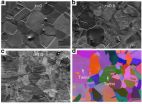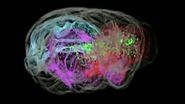(Press-News.org) Recently, dark matter hunters from around the world gathered at the University of California, Los Angeles for "Dark Matter 2014." The annual conference is one of the largest of its kind aimed at discussing the latest progress in the quest to identify dark matter, the unknown stuff that makes up more than a quarter of the universe yet remains a mystery.
So where does the hunt stand? Between sessions, three leading physicists at the conference spent an hour discussing the search for dark matter on several fronts.
"This conference has highlighted the progression of larger and larger experiments with remarkable advances in sensitivity," says Blas Cabrera, Professor of Physics at Stanford University and Member of the Kavli Institute for Particle Astrophysics and Cosmology at Stanford. "What we're looking for is evidence of a dark matter particle, and … we believe (this particle) interacts with ordinary matter only very rarely."
Says Dan Hooper, Associate Professor in the Department of Astronomy and Astrophysics at the University of Chicago, and Senior Member of the Kavli Institute for Cosmological Physics at the university: "Four and a half years ago, I wrote my first paper on searching for evidence of dark matter at the center of the Milky Way galaxy. And now we think we have the most compelling results to date."
Tim Tait, Professor of Physics and Astronomy at the University of California Irvine is involved in looking for evidence of dark matter by colliding subatomic particles at the Large Hadron Collider, or LHC, in Europe. Says Tait: "Supersymmetry proposes there are mirror particles that shadow all the known fundamental particles, and in this shadow world may lurk the dark matter particle. So, by smashing together protons in the LHC, we've tried to reveal these theoretical supersymmetric particles. So far, though, the LHC hasn't found any evidence for supersymmetry."
What would a discovery mean? Says Cabrera: "We would have identified the dominant form of matter in the universe that seeded structure and led to galaxies, solar systems and planets, and ultimately to our Earth with intelligent life."
INFORMATION:
Available at: http://www.kavlifoundation.org/science-spotlights/searching-high-low-dark-matter
Searching high and low for dark matter
How is the hunt for dark matter going? Researchers from around the world recently gathered at UCLA to take stock of their progress
2014-04-08
ELSE PRESS RELEASES FROM THIS DATE:
The long reach of Alzheimer's
2014-04-08
LEBANON, NH – To address the burgeoning demands of Alzheimer's disease that will affect generations, new policies will have to be adopted to acknowledge the complex and unique needs of people with dementia.
The aging of the U.S. population has turned the prism to focus on the increasing number of families facing the challenge of providing care for people with dementia, said Julie P.W. Bynum, associate professor at The Dartmouth Institute for Health Policy & Clinical Practice. Writing in the April issue of Health Affairs, she says the "long reach" of Alzheimer's will ...
Experimental drug shows promise for treatment-resistant leukemias
2014-04-08
Research in mice and human cell lines has identified an experimental compound dubbed TTT-3002 as potentially one of the most potent drugs available to block genetic mutations in cancer cells blamed for some forms of treatment-resistant leukemia.
Results of the research by Johns Hopkins Kimmel Cancer Center investigators, described March 6 in the journal Blood, show that two doses a day of TTT-3002 eliminated leukemia cells in a group of mice within 10 days. The treatment performed as well as or better than similar drugs in head-to-head comparisons.
More than 35 percent ...
Location matters when it comes to deal-making, says new study
2014-04-08
Toronto – Even six-year-olds know who you sit beside matters, whether you're in first grade or at a high-powered dinner.
But now a new study, using the U.S. Senate Chamber as its laboratory, provides documented evidence of that phenomenon. It shows that where a person is located influences who they interact with and who they will turn to in order to build support for their own agenda.
For the powerful however, seating arrangements don't make much of a difference. That's because the people they need support from usually come to them.
The study's researchers chose ...
A new twist makes for better steel, researchers find
2014-04-08
PROVIDENCE, R.I. [Brown University] — Researchers from Brown University and universities in China have found a simple technique that can strengthen steel without sacrificing ductility. The new technique, described in Nature Communications, could produce steel that performs better in a number of structural applications.
Strength and ductility are both crucial material properties, especially in materials used in structural applications. Strength is a measure of how much force is required to cause a material to bend or deform. Ductility is a measure of how much a material ...
NASA's Aqua satellite reveals Tropical Cyclone Ita strengthening
2014-04-08
Tropical Cyclone Ita's maximum sustained winds have increased over the last day and NASA's Aqua satellite provided forecasters at the Joint Typhoon Warning Center with a visible look at the storm on April 8.
NASA's Aqua satellite passed over Ita at 3:30 UTC/11:30 p.m. EDT on April 7, and the Moderate Resolution Imaging Spectroradiometer provided a visible image of Tropical Cyclone Ita. The MODIS image showed a large area of strong thunderstorms south and northeast of the center of circulation. At the same time, the Atmospheric Infrared Sounder or AIRS instrument aboard ...
Scientists reveal potential link between brain development and breast cancer gene
2014-04-08
VIDEO:
Scientists at the Salk Institute have uncovered details into a surprising -- and crucial -- link between brain development and BCRA1, a gene whose mutation is tied to breast and ovarian cancer.
Click here for more information.
LA JOLLA—Scientists at the Salk Institute have uncovered details into a surprising—and crucial—link between brain development and a gene whose mutation is tied to breast and ovarian cancer. Aside from better understanding neurological damage associated ...
Why binge drinkers are slower to heal from their wounds
2014-04-08
MAYWOOD, Ill. – People who are injured while binge drinking are much slower to heal from wounds suffered in car accidents, shootings, fires, etc.
Now a new study is providing insights into why alcohol has such a negative effect on wound healing. Loyola University Chicago Stritch School of Medicine researchers report that binge alcohol exposure significantly reduced levels of key components of the immune system involved in healing.
The study by senior author Katherine A. Radek, PhD, and colleagues from Loyola's Alcohol Research Program and the Infectious Disease and ...
Global health funding reaches new high as funding priorities shift
2014-04-08
Washington, D.C.—Global health funding hit an all-time high of $31.3 billion in 2013, five times greater than in 1990. Yet with 3.9% growth from 2012 to 2013, the year-over-year increase falls short of the rapid rates seen over the previous decade, according to new research by the Institute for Health Metrics and Evaluation (IHME) at the University of Washington being published online in a web first edition on April 8 by Health Affairs.
As funding from many bilateral donors and development banks has declined, growth in funding from the GAVI Alliance, the Global Fund ...
UNC researchers find genetic trigger for RSV-induced infant hospitalizations
2014-04-08
April 8, 2014 CHAPEL HILL, N.C. – Researchers at UNC School of Medicine have pinpointed a viral protein that plays a major role in making respiratory syncytial virus (RSV) the most common cause of hospitalization in children under one year of age.
The discovery, published April 8 in the Journal of Clinical Investigation, is the first step toward identifying better diagnostics and potential treatments for an infection that strikes nearly all children before they reach the age of three and causing severe disease in 3 percent of infected children. RSV infection leads to ...
The double whammy of multiple sex partners and drinking in HIV/STI prevention
2014-04-08
PHILADELPHIA (April 8, 2014) – The cartoon character Homer J. Simpson once said "Alcohol: The source of, and solution to, all of life's problems."
The sage of the ubiquitous and fictional town of Springfield may have hit the nail on the head when it comes to human immunodeficiency virus (HIV) and sexually transmitted infections (STIs) counseling and prevention. The more you drink and/or the more sex partners you have, the less likely you are to engage in HIV-prevention programs.
This rather grim assessment came about from the study, "Barriers to accessing HIV-prevention ...
LAST 30 PRESS RELEASES:
Heart-brain connection: international study reveals the role of the vagus nerve in keeping the heart young
Researchers identify Rb1 as a predictive biomarker for a new therapeutic strategy in some breast cancers
Survey reveals ethical gaps slowing AI adoption in pediatric surgery
Stimulant ADHD medications work differently than thought
AI overestimates how smart people are, according to HSE economists
HSE researchers create genome-wide map of quadruplexes
Scientists boost cell "powerhouses" to burn more calories
Automatic label checking: The missing step in making reliable medical AI
Low daily alcohol intake linked to 50% heightened mouth cancer risk in India
American Meteorological Society announces Rick Spinrad as 2026 President-Elect
Biomass-based carbon capture spotlighted in newly released global climate webinar recording
Illuminating invisible nano pollutants: advanced bioimaging tracks the full journey of emerging nanoscale contaminants in living systems
How does age affect recovery from spinal cord injury?
Novel AI tool offers prognosis for patients with head and neck cancer
Fathers’ microplastic exposure tied to their children’s metabolic problems
Research validates laboratory model for studying high-grade serous ovarian cancer
SIR 2026 delivers transformative breakthroughs in minimally invasive medicine to improve patient care
Stem Cell Reports most downloaded papers of 2025 highlight the breadth and impact of stem cell research
Oxford-led study estimates NHS spends around 3% of its primary and secondary care budget on the health impacts of heat and cold in England
A researcher’s long quest leads to a smart composite breakthrough
Urban wild bees act as “microbial sensors” of city health.
New study finds where you live affects recovery after a hip fracture
Forecasting the impact of fully automated vehicle adoption on US road traffic injuries
Alcohol-related hospitalizations from 2016 to 2022
Semaglutide and hospitalizations in patients with obesity and established cardiovascular disease
Researchers ‘listen in’ to embryo-mother interactions during implantation using a culture system replicating the womb lining
How changing your diet could help save the world
How to make AI truly scalable and reliable for real-time traffic assignment?
Beyond fragmented markets: A new framework for efficient and stable ride-pooling
Can shape priors make road perception more reliable for autonomous driving?
[Press-News.org] Searching high and low for dark matterHow is the hunt for dark matter going? Researchers from around the world recently gathered at UCLA to take stock of their progress





